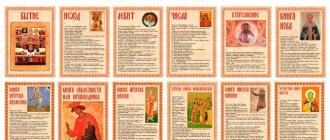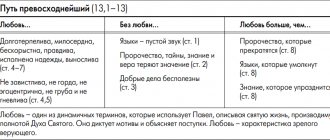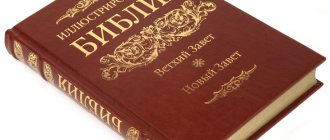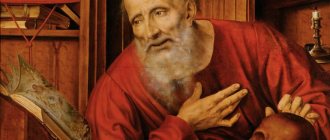This exciting message is written to teach and encourage, talking about practical holiness and calling Christians to active faith.
The Catholic Epistle of James, like the epistles of Peter, John and Jude, is addressed not to any specific church or individual, but to all believers in general. It complements Paul's teaching as he laid it out in his letters. The main theme of Paul's letters is faith , James focuses on Christian behavior , Peter on hope , John on love, Jude on purity.
Author of the Epistle of James
The New Testament tells us about four followers of Christ who lived in His time, who bore the name Jacob:
- son of Zebedee and brother of John (Mark 1:19),
- son of Alphaeus (Mark 3:18),
- father of Judas (not Iscariot; Luke 6:16),
- brother of the Lord (Gal. 1:19).
The book known as the Epistle of James appears to have been written by one of them.
Which of the 4 Jacobs became the author of the Epistle?
James, the son of Zebedee, could not have been its author, since he was killed before the epistle was written (Acts 12:2). It is unlikely that the little-known Jacob, son of Alpheus, could have written it. James, the father of Judas, was also not particularly famous among the early Christians. It is therefore difficult to assume that the message was written by him.
It remains to be assumed that the letter was written by James, the brother of Jesus, who became a prominent leader of the Jerusalem church. Although James grew up in the same family with Jesus, he apparently did not believe in Him until after His resurrection from the dead, according to the words of the evangelist John:
“For neither did His brothers believe in Him” (John 7:5) .
The meeting with the risen Christ instilled saving faith in Jacob, and Paul writes about this: “then he appeared to James, and also to all the apostles” (1 Cor. 15:7) . The Apostle Paul noted the fact that James, Peter and John were considered “pillars of the church” (Gal. 2:9).
So, most likely this letter was written by James, the brother of Jesus in the flesh. And such prominent early Christian figures as Origen, Cyril of Jerusalem, Athanasius, Augustine and many others adhered to precisely this point of view.
EPISTLE OF JAMES
Although Eusebius of Caesarea (Euseb. Hist. eccl. 6. 14. 1) and Cassiodorus (Cassiod. De inst. div. lit. I 8. 4) argued that Clement of Alexandria already wrote an interpretation on IP, in the surviving works There are no quotations from Clement (including the Latin translation of his interpretation of the Council Epistles - Adumbrationes in Epistulas Catholicas; only interpretations of 1 Peter, 1 John and Jude have been preserved).
Cassiodorus also notes that the interpretation of all 7 Council Epistles was compiled by Didymus the Blind. According to him, the text of Didymus was translated into Latin. language by Epiphanius Scholasticus (Cassiod. De inst. div. lit. 8. 6). However, blzh. This work of Didymus was unknown to Jerome.
Cosmas Indicoplous (VI century), a merchant from Alexandria who became a monk and became famous as the author of “Christian Topography,” testifies that in his time not a single interpretation of the Council Epistles was known (Cosm. Indic. Topogr. chr. 7. 68). Perhaps Cosmas had in mind complete interpretations of all 7 Epistles, since Cassiodorus already knew at least 4 works - Clement of Alexandria on 1 Peter, 1-2 John and IP, translated into Latin. language, interpretation of Augustine on I.P. (now lost), his 10 sermons on 1 John and interpretation of Didymus.
Lat. the text of Didymus's interpretation of the Council Epistles was first published in 1531 (Didymi Alexandrini Praeceptoris Divi Hieronymi in omnes epistolas canonicas brevis enarratio. Coloniae, 1531). The critical edition was prepared by F. Zoepfl (Didymi Alexandrini In epistolas canonicas brevis enarratio / Hrsg. F. Zoepfl. Münster, 1914). IP is commented on in fragments.
Several are known. Greek caten with interpretations on the Council Epistles (Matthaei CF SS. Apostolorum septem catholicae. Rigae, 1782. P. 183 ff.; reprinted from the Latin translation by F. Lücke (Lücke F. Quaestiones ac vindiciae Didymianae. Gött., 1829-1832 . 4 Bde) included in the Patrology of Min (PG. 39. Col. 1749-1818)) and the edition of J. Cramer (Cramer JA Catenae graecorum patrum in Novum Testamentum. Oxonii, 1844. T. 8. Fragm. 2, 30, 52 -53, 65). Kramer relied on 2 Oxford manuscripts early. XII century - Bodl. New College. 58 and Bodl. Rawl. gr. 157, cited discrepancies in Paris. Coislin. 25, 10th century, and Bodl. Misc. 169, X-XI centuries.
Fragments similar to those published by Kramer were discovered by S. Renu in Armenian. catenas on the Council Epistles (Renoux Ch. La chaîne armènienne sur les Épîtres Catholiques. Turnhout, 1985. Vol. 1: La chaîne sur l'Épître de Jacques. P. 70, 132. (PO; 43/1); 1987. Vol. 2: La chaîne sur les Épîtres de Pierre. P. 98, 122, 126. (PO; 44/2)).
K. Staab tried among the Greeks. fragments of catenas to isolate the original texts of Didymus (Staab K. Die griechischen Katenenkommentare zu den katholischen Briefen // Biblica. 1924. Vol. 5. P. 296-353). In addition to Kramer's materials, he used the manuscripts: Vat. Barber. Gr. 582, XII century; Roma. Bibl. Casanat. 1395, XVI century; Vat. gr. 1430, XI century
J. Ropes pointed out a number of other manuscripts containing catenas on the Council Epistles: State Historical Museum. Syn. Greek No. 97(93), 9th century; Hieros. S. crucis. 25, 9th century; Laurent. VI 5, X century; Paris. 221, XII century; Ath. Vatop. 300, XI-XII centuries. (Ropes JH The Greek Catena to the Catholic Epistles // HarvTR. 1926. Vol. 19. N 4. P. 383-388).
There are still doubts about the reliability of Cassiodorus' message and the attribution of the discovered Latin interpretation and Greek catenas. Authenticity of lat. text in the XVIII-XIX centuries. recognized by L. S. Tiimon and card. Angelo Mai. According to R. Seye, this interpretation is not a translation, but an original work of Lat. author (Ceillier R. Histoire générale des auteurs sacrés et écclesiastiques. P., 18602. Vol. 5. P. 379-441). Priest He quoted Scripture from the Vulgate, while Epiphanius Scholasticus usually left the Greek biblical texts intact when translating, as can be seen from the surviving translation of Historia tripartita. Although Cassiodorus in the above place says that he specially selected strictly Orthodox Christians for the monks. essays, in lat. the text clearly shows inclinations towards Origen’s teaching on apocatastasis, and in the interpretation of the 1st Epistle of John one can also note the influence of the teaching of Eutyches (PG. 39. Col. 1800). G. Bardi believed that in lat. The text contains genuine excerpts from Didyme's work, translated by Epiphanius, but in general it is a compilation of the works of different authors (Bardy G. Didyme l'Aveugle. P., 1910. P. 54-55). The same t.zr. adhered to E. Klostermann (Klostermann E. Über des Didymus von Alexandrien “In epistulas canonicas enarratio”. Lpz., 1905. (TU; 28/2)), who compared the lat. text from Greek Cramer's catenas. He noticed that a number of passages from Lat. of the text of Didymus in Kramer's catenas appears under other names (Origen, John Chrysostom, Sevirus), and vice versa, in Greek. There are several texts. passages attributed to Didymus, which are not in Lat. translation. Thus, according to Klostermann, lat. the text is a translation of the Greek. catena, to which the general title was given after the name of the 1st author in the catenas - Didymus. Zöpfl argued that Didymus's interpretation formed the core of the Latin text, replete with interpolations and later additions. He was supported by R. Devresse (Devresse R. Chaines exégétiques grecques // Dictionnaire de la Bible. Suppl. / Ed. L. Pirot. P., 1928. Vol. 1. Col. 1226-1227). According to B. J. Bennett, Didymus did not compose a complete interpretation of the Council Epistles (Bennett B. J. Didymus the Blind's Contra Manichaeos and its Debt to Origen's Theology and Exegesis. Toronto, 1997. P. 30).
One of the Greek texts, interpretation on James 1. 1, which has parallels in Lat. and Armenian manuscripts, bears the name Didymus and is an excerpt from Didymus’s interpretation of the psalms, which was preserved in the catenas and discovered among the works of Didymus found in Tours (on Ps 85. 2-3; see: Didymus der Blinde. Psalmenkommentare aus der Katenenüberlieferung / Hrsg E. Mühlenberg B., 1977. Bd. 2. S. 155).
The interpretation of James 4.6 in the Greek catenae (available in the Armenian catenae, but not in the Latin text), published by Kramer, was probably borrowed from Didymus’ interpretation of the Book of Proverbs of Solomon (in I.P. Proverbs 3 is quoted at this point. 34), but it is impossible to verify this until a critical edition of the interpretations of this book appears.
Blzh. Augustine, who often referred to I.P., testified that his students collected and published a book with his notes to I.P.; recognizing the benefit of this work, he nevertheless noted that he did not then have at hand a high-quality translation of the text of the Epistle from Greek (Aug. Retractat. 2.32). Probably for this reason, its interpretation in I.P. has not been preserved.
The first full lat. the interpretation in IP is considered to be the treatise preserved under the name of Hilary of Arelat (Ɨ 449) (Pt. 1. Tractatus Hilarii in septem epistulas catholicas // Scriptores Hiberniae minores / Ed. RE McNall. Turnhout, 1973. P. 53-124. (CCSL; 108B)). In medieval lat. tradition, the interpretation on I.P. Beda the Venerable (Beda Venerabilis. Super epistolas catholicas expositio // PL. 93. Col. 9-42; Idem. In Jac.), which in the era of scholasticism was supplanted by Glossa ordinaria, was popular.
In the Churches of the Byzantine tradition, the main interpretations are: attributed to Ikumenius (Pseudo-Oecumenius. Commentarii in Epistulas Catholicas // PG. 119. Col. 455-510), St. Theophylact of Bulgaria (Theoph. Bulg. Expositio Epistolarum Catholicarum // PG. 125. Col. 1131-1190) and Euthymii Zigaben (Euthymii Zigabeni Commentarius in XIV epistolas S. Pauli et VII catholicas / Ed. N. Calogeras. Athenis, 1887. T .2).
In East Syria tradition knows the interpretation of the Council Epistles of Isho'dad of Merv (The Commentaries of Isho'dad of Merv / Ed. and transl. MD Gibson. Camb., 1913. Vol. 4).
Lit.: Comment: Spitta F. Der Brief des Jakobus untersucht. Gott., 1896; Mayor JB The Epistle of St. James. L., 1897 2; Ropes JH A Critical and Exegetical Comment. on the Epistle of St. James. Edinb., 1916; Chaine J. L'épître de St. Jacques. P., 1927; Moffatt J. The General Epistles: James, Peter and Judas. L., 1928; Marty J. L'épître de Jacques: Étude crit. P., 1935; Schneider J. Die Briefe des Jakobus, Petrus, Judas und Johannes: Die “katholischen” Briefe. Gött., 1961 9. (Das NT Deutsch; 10); Mussner F. Der Jakobusbrief. Freiburg, 1964; Reicke BI The Epistles of James, Peter and Jude. Garden City (NY), 1964. (The Anchor Bible; 37); Mitton CL The Epistle of James. L., 1966; Sidebottom E. M. James, Jude, and 2 Peter. L., 1967; Cantinat J. Les Épîtres de St. Jacques et de St. Jude. P., 1973; Schrage W., Balz HR Die “katholischen” Briefe: Die Briefe des Jakobus, Petrus, Judas und Johannes. Gött., 1973 11. (Das NT Deutsch; 10); Adamson JB The Epistle of James. Grand Rapids, 1976. (NICNT); Dibelius M. James / Transl. MA Williams. Phil., 1976; Laws SS A Commentary on the Epistle of James. L., 1980. (BNTC); Davids PH The Epistle of James. Grand Rapids, 1982 (NIGTC); Moo DJ The Letter of James. Leicester; Grand Rapids, 1985; Kistemaker SJ The New Testament Commentary: Exposition of the Epistle of James and the Epistles of John. Grand Rapids, 1986; Martin R.P. James. Waco (Tex.), 1988. (WBC; 48); Johnson LT The Letter of James. NY; L., 1995. (The Anchor Bible; 37A); Wall RW The Community of the Wise: The Letter of James. Valley Forge (Penn.), 1997; Bauckham R. James: Wisdom of James, Disciple of Jesus the Sage. L.; NY, 1999; Burchard C. Der Jakobusbrief. Tüb., 2000. (Handb. zum NT; 15/1).
Research: Halévy J. Lettre d'un rabbin de Palestine égarée dans l'évangile // Revue sémitique. 1914. Vol. 22. P. 197-201; idem. Lettre d'un missionaire essénien égarée dans l'évangile // Ibid. P. 202-206; Burkitt FC Christian Beginnings. L., 1924. P. 65-70; Meyer A. Das Rätsel des Jakobusbriefes. Giessen, 1930; Aland K. Der Herrnbruder Jakobus und der Jakobusbrief // ThLZ. 1944. Bd. 69. S. 97-104; Thyen H. Der Stil der jüdisch-hellenistischen Homilie. Gott., 1955; Gertner M. Midrashic Terms and Techniques in the NT: The Epistle of James, a Midrash on a Psalm // Studia Evangelica. B., 1964. Vol. 3. P. 463. (TU; 88); Francis FO The Form and Function of the Opening and Closing Paragraphs of James and I John // ZNW. 1970. Bd. 61. S. 110-126; Dory W. Letters in Primitive Christianity. Phil., 1973; Turner N. The Style of the Epistle of James // A Grammar of NT Greek / Ed. J. H. Moulton, N. Turner. Edinb., 1976. Vol. 4: Style. P. 114-120; Zmijewski J. Christliche Vollkommenheit: Erwägungen zur Theologie des Jakobusbriefes // StNTU. 1980. Bd. 5. S. 50-78; Amphoux C.-B. Systèmes anciens de division de l'épître de Jacques et composition littéraire // Biblica. 1981. Vol. 62. N 3. P. 390-400; Luhrman D. Gal 2. 9 und die katholischen Briefe // ZNW. 1981. Bd. 72. N 1/2. S. 65-87; Perdue LG Paraenesis and the Epistle of James // Ibid. N 3/4. S. 241-256; Johnson LT The Use of Leviticus 19 in the Letter of James // JBL. 1982. Vol. 101. N 3. P. 391-401; Hengel M. Der Jakobusbrief als antipaulinische Polemik // Tradition and Interpretation in the NT / Ed. G. F. Hawthorne, O. Betz. Grand Rapids, 1987, pp. 248-278; Deppe DB The Sayings of Jesus in the Epistle of James. Chelsea (Mich.), 1989; Guthrie D. New Testament Introduction. Downers Grove (Ill.), 1990 4; Hartin PJ James and the Q Sayings of Jesus. Sheffield, 1991. (JSNT. Suppl.; 47); Penner T.C. The Epistle of James and Eschatology. Sheffield, 1996. (JSNT. Suppl.; 121); Syreeni K. James and the Pauline Legacy: Power Play in Corinth? // Fair Play: Diversity and Conflicts in Early Christianity: Essays in Honor of H. Räisänen / Ed. I. Dunderberg et al. Leiden; Boston, 2002. P. 397-437; Wall RW Toward a Unifying Theology of the Catholic Epistles: A Canonical Approach // The Catholic Epistles and the Tradition / Ed. J. Schlosser. Leuven, 2004. P. 43-71. (BETL; 176); Kloppenborg JS Diaspora Discourse: The Construction of Ethos in James // NTS. 2007. Vol. 53. N 2. P. 242-270; Nienhuis DR Not by Paul Alone: The Formation of the Catholic Epistle Collection and the Christian Canon. Waco (Tex.), 2007.
A. A. Tkachenko
To whom is it addressed?
James writes that his letter is addressed to “ the twelve tribes that were scattered abroad ” ( James 1:1 ). The flavor of Judaism is clearly inherent in it. In its authoritative tone the message is similar to the prophetic books, and in its style and beauty it is similar to the book of Psalms.
Despite the fact that some theologians believe that the expression “the twelve tribes scattered” should be understood in a figurative sense, as “the pagan church scattered throughout the Roman Empire,” it turns out that it is more correct to understand these words literally. The message is truly addressed to a Jewish audience. Although it is written in immaculate Greek, it has a distinctly Jewish symbolism.
Apparently, the Apostle Peter wrote to Jewish Christians living in the West (1 Pet. 1:1), and James wrote to Jewish Christians living in the East, in Babylon and Mesopotamia.
The message was for all Christians who lived in different countries of the planet
It is interesting to note that in some of the early collections of the Holy Books that have come down to our time, the epistle of James is not present. However, the earliest of these collections, which is known as the “Muratorial” and dates back to the second century AD, does not include not only the Epistle of James, but also the Epistle to the Hebrews, as well as the Epistles of Peter. The Epistle of James began to be permanently included in the canon of Holy Books only from the 4th century.
The epistle of James is both a letter and a lecture. It begins with the usual greeting for a letter, but it does not contain the personal address inherent in a letter, nor does it contain the final blessing, also characteristic of Christian churches. Apparently, it was not intended as a message, but as a public sermon to be read in churches. It is expressed in a clearly authoritative, although not dictatorial, tone. The 108 verses of the text contain 54 commands, i.e., on average there is a call to action every second verse!
The speaking style is energetic and lively, with deep thoughts conveyed in clear, well-thought-out words. The sentences are simple, clear and short. The message contains many metaphors and poetic comparisons. It probably contains more figures of speech, analogies, and comparisons taken from natural life than all the letters of Paul. This small book devotes a lot of space to exhortations, rhetorical questions, and examples from everyday life.
Jacob achieves a striking literary effect by connecting sentences and their individual parts together by repeating the main meaning of the word or using another word that is identical to it. For example: one verse ends with a phrase and the next verse of the same chapter begins with it. In verse 4 of the 1st chapter: “without any lack” and in verse 5: “if anyone lacks”; in verse 5: “let him ask,” and in verse 6: “but let him ask in faith”; in verse 6: “doubting not the least,” and in the second half of the same verse: “because he who doubts”
In addition to his unusually innovative style, James makes many references to the Old Testament scriptures . He has direct references to Abraham, Rahab, Job, Elijah, and the Ten Commandments, as well as allusions from the books of the Old Testament ranging from (Genesis to Deuteronomy, Joshua, 3 Kings, Psalms, Proverbs, Ecclesiastes, Isaiah, Jeremiah, Ezekiel, Daniel and seven of the 12 minor prophets).
The Old Testament is the basis
The teaching of James bears traces of the direct influence of John the Baptist. It is quite possible that James, like Peter, John and Andrew, himself listened to the sermons of John the Baptist in his time. An amazing parallelism can also be seen between the letter of James and Christ's Sermon on the Mount, recorded in Matthew 5-7. James does not repeat the words of Christ, but analyzes them and conveys to his listeners the teaching of Christ in all its depth.
Thanks to the expressiveness, brevity and strict simplicity inherent in his language, Jacob created a truly literary masterpiece. The message is beautiful in form and deeply impressive in its content.
Council Epistle of the Apostle James
1
Jacob, servant of God and the Lord Jesus Christ, to the twelve tribes that are scattered, rejoice!
2
Whenever you fall into various temptations, consider it great joy for yourself, my brothers,
3
Knowing that the testing of your faith produces endurance.
4
But let patience have its perfect work, so that you may be perfect and undefiled, lacking nothing.
5
If any of you lacks wisdom, let him ask God, who gives generously to all without reproach, and it will be given to him.
6
But let him ask in faith, without any doubt; for he who doubts is like a wave of the sea, tossed and tossed by the wind.
7
Let such a person not think that he will receive anything from the Lord.
8
A man with a split soul is not firm in all his ways.
9
Let the humble brother boast in his greatness,
10
and the rich man - by his humiliation, because, like a flower on the grass, he will pass away.
11
For the sun rises with heat and withers the grass, and its flower fades, and the beauty of its appearance perishes: so will the rich man wither in his ways.
12
Blessed is the man who endures temptation, because having been tried, he will receive the crown of life that the Lord has promised to those who love Him.
13
When tempted, let no one say: God is tempting me. For God is inaccessible to the temptation of evil and He Himself does not tempt anyone.
14
But everyone is tempted, carried away and deceived by his own lust.
15
Then lust, having conceived, gives birth to sin, and sin, being committed, gives birth to death.
16
Do not be deceived, my beloved brothers.
17
Every good gift and every perfect gift is from above, coming down from the Father of lights, with whom there is no variableness or shadow of turning.
18
He, having willed, gave birth to us by the word of truth, so that we might be a kind of firstfruits of His creatures.
19
Know this, my beloved brothers: let every man be quick to hear, slow to speak, slow to anger;
20
for the anger of man does not create the righteousness of God.
21
Therefore, putting aside all uncleanness and the remainder of malice, meekly receive the word implanted in you, which is able to save your souls.
22
Be ye doers of the word, and not merely hearers deceiving yourselves,
23
because if anyone listens to the word and does not do it, he is like a man looking at the natural features of his face in a mirror.
24
He looked at himself and left, and immediately forgot what he was like.
25
But whoever delves into the perfect law, the law of freedom, and remains in it, not being a forgetful listener, but a doer of the work, he will be blessed in the fulfillment of the work.
26
If anyone thinks that he is pious and does not bridle his tongue, but deceives his heart, his piety is useless.
27
Pure and undefiled piety before God and the Father means visiting orphans and widows in their sorrow, keeping oneself undefiled from the world.
Application
The purpose of this outstanding message was to call the early believers to achieve spiritual growth and demonstrate holiness in their lives . The message touches on the practical side of Christian life, and to a lesser extent on Christian teaching. James explains to his readers how they can practically achieve spiritual maturity through personal endurance and selfless service by being self-controlled, humble, and sacrificial. James touches on all aspects of Christian life: what a Christian should be, how he should act, speak and feel, what to strive for.
Purpose of writing
Some think that this epistle was written in response to extreme interpretations of Paul's teaching on the faith. This position, called antinomianism , stated that through faith in Christ a person is completely freed from the Old Testament law, legalism, secular laws and any moral orders of society. The letter of James is directed to Jewish Christians scattered among all nations.
Martin Luther , who hated this letter and called it a " letter of straw ", failed to understand that James's teaching on works complemented, but did not contradict, Paul's teaching on faith. While Paul's teachings focused on our justification by God, James's teaching emphasized works that illustrated that justification. James wrote for the Jews to encourage them to continue to grow in this new Christian faith. He emphasizes that good actions are a characteristic of those who are filled with the Spirit, and he questioned whether anyone could have saving faith if the fruits of the Spirit described by Paul in Galatians 5:22–23 were not evident.
To the twelve families of the Jews, scattered among the nations.
Welcome to Jacob, servant of God and the Lord Jesus Christ.
Wisdom and Faith
Brethren, when you encounter trials of various kinds, consider it great joy. You know that the testing of your faith produces perseverance, and perseverance must grow in you so much that you become mature and whole, without any defects. If any of you lacks wisdom, let him ask God, who, without reproaching, generously imparts it to everyone, and it will be given to him. But the one who asks must believe without any doubt, because the one who doubts is like a wave of the sea, carried and broken by the wind. Let such a person not expect to receive anything from the Lord. This is a double-minded person, unsteady in everything he does.
Wealth doesn't last forever
A brother from a lower class can actually boast of his high position. But the rich man can boast of his humiliation, because he will disappear like a wild flower. The sun rises and dries the plant with its heat, its flower falls, and all beauty disappears. Likewise, a rich man will wither away in his affairs.
Blessed is the one who, having endured a trial, endures it to the end - he will receive the crown of life that God has promised to all who love Him. When you are tempted, do not say, “It is God who is tempting me.” God Himself cannot be tempted by evil and does not tempt anyone. Every person is tempted by his own desires, they carry him away and seduce him. Then desire conceives and gives birth to sin, and sin done gives birth to death.
My beloved brothers, do not be mistaken. All good and perfect gifts come from above, from the Father of the lights, with whom there is no variation or shadow of turning. He Himself, of His own will, begot us by the word of truth, so that we might be the first fruits among His creatures.
Words and actions
My beloved brethren, understand that let everyone be inclined to listen rather than speak or show anger. In anger, a person does not do what is pleasing to God. Therefore, leave behind all uncleanness and the remnant of malice, and meekly receive the implanted word, which has the power to save your souls.
At the same time, be not only listeners of the word, but also doers of it, otherwise you are simply deceiving yourself. He who listens to the word but does not fulfill it is like a man who looks in the mirror: he looked at himself, walked away and immediately forgot what he looked like. But a person who constantly delves into the perfect Law, the Law that gives freedom, and acts according to it, not forgetting what he has heard, will be blessed in his affairs.
He who thinks himself pious, but cannot control his tongue, deceives himself, and the piety of such a person is useless. Pure and undefiled godliness before God our Father consists in helping orphans and widows in their needs and keeping ourselves clean from this world.
a) 1:2 By trials—or “temptations.”
b) 1:10-11 See Isa. 40:6-7; 1 Pet. 1:24.
c) 1:12 The crown of life is the gift of eternal life after death, but perhaps it could be a full, perfect life here on earth.
d) 1:18 Firstfruits - the first harvest, the firstborn of animals and people in ancient times were considered sacred and dedicated to God (see, for example, Exod. 13:1-2; Lev. 23:9-14; Num. 3:12 ; 15:20-21; Deut. 15:19-23; 26:1-11). In this text there can be four interpretations of the expression “firstfruits”: 1) believers in Jesus Christ are people who are dedicated to God; 2) the followers of Christ are the first (chronologically) among the “new creation” (see Rom. 8:19-21; Rev. 21:1-5); 3) first fruits are a sign of a future harvest, and perhaps in this sense the early (first) followers of Jesus Christ are called first fruits; 4) believers in Christ have a special position in the eyes of God. It is likely that several of the above options may be correct.








